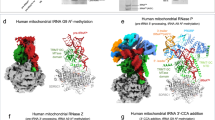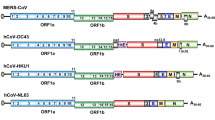Abstract
Initiation of translation of genomic RNA (gRNA) of hepatitis C virus (HCV) is provided by a highly structured fragment in its 5′-untranslated region, the so-called Internal Ribosome Entry Site (IRES). In this work, the exposed NH2-groups of proteins in the 40S subunit of the human ribosome and in its binary complexes with RNA transcripts corresponding to the full-size HCV IRES or its fragments were probed using the N-hydroxysuccinimide derivative of the fluorescent dye Cy3. Comparison of efficiencies of modification of ribosomal proteins in free subunits and in their binary complexes with the RNA transcripts revealed ribosomal proteins involved in the HCV IRES binding. It was found that binding of the 40S subunits with the RNA transcript corresponding to full-size HCV IRES results in a decrease in modification levels of ribosomal protein (rp) S27 and, to a lesser extent of rpS10; also, a noticeable decrease in the efficiency of labeling of proteins RACK1/S2/S3a was observed. When a fragment of HCV IRES containing the initial part of the open reading frame (ORF) of the viral gRNA was deleted, the level of rpS10 modification became the same as in free subunits, whereas the levels of modification of rpS27 and the RACK1/S2/S3a group remained virtually unchanged compared to those observed in the complex of 40S subunit with the full-size HCV IRES. Binding of 40S subunits to a fragment of the HCV IRES lacking an ORF and domain II increased the modification level of the RACK1/S2/S3a proteins, while the efficiencies of labeling of rpS10 and rpS27 remained the same as upon the deletion of the ORF fragment. Comparison of these results with known structural and biochemical data on the organization of 40S subunit and the location of the HCV IRES on it revealed structural elements of the IRES contacting exposed lysine residues of the above-mentioned ribosomal proteins. Thus, it was found that the majority of exposed lysine residues of rpS27 are involved in the binding of the HCV IRES region formed by the junction of subdomains IIIa, IIIb, and IIIc with the central stalk of domain III, and that several lysine residues of rpS10 participate in the binding of the HCV IRES region corresponding to the initial part of the ORF of the viral gRNA. In addition, we concluded that lysine residues of rpS3a are involved in the binding of domains II and III of HCV IRES.
Similar content being viewed by others
Abbreviations
- cryo-EM:
-
cryoelectron microscopy
- HCV:
-
hepatitis C virus
- IRES:
-
internal ribosome entry site
- NHS-Cy3:
-
1,1′-(3-dihydroxypropyl)-3,3,3′,3′-tetramethylindocarbocyanine N-hydroxysuccinimide ester
- ORF:
-
open reading frame
- rp:
-
ribosomal protein
- 5′-UTR:
-
5′-untranslated region
References
Jackson, R. J., Hellen, C. U., and Pestova, T. V. (2010) Nat. Rev. Mol. Cell. Biol., 11, 113–127.
Merrick, W. C. (2004) Gene, 332, 1–11.
Rijnbrand, R., Bredenbeek, P., van der Straaten, T., Whetter, L., Inchauspe, G., Lemon, S., and Spaan, W. (1995) FEBS Lett., 365, 115–119.
Reynolds, J. E., Kaminski, A., Kettinen, H. J., Grace, K., Clarke, B. E., Carroll, A. R., Rowlands, D. J., and Jackson, R. J. (1995) EMBO J., 14, 6010–6020.
Honda, M., Beard, M. R., Ping, L. H., and Lemon, S. M. (1999) J. Virol., 73, 1165–1174.
Brocard, M., Paulous, S., Komarova, A. V., Deveaux, V., and Kean, K. M. (2007) Virus Genes, 35, 5–15.
Pestova, T. V., Shatsky, I. N., Fletcher, S. P., Jackson, R. J., and Hellen, C. U. (1998) Genes Dev., 12, 67–83.
Boehringer, D., Thermann, R., Ostareck-Lederer, A., Lewis, J. D., and Stark, H. (2005) Structure, 13, 1695–1706.
Spahn, C. M., Kieft, J. S., Grassucci, R. A., Penczek, P. A., Zhou, K., Doudna, J. A., and Frank, J. (2001) Science, 291, 1959–1962.
Fukushi, S., Okada, M., Stahl, J., Kageyama, T., Hoshino, F. B., and Katayama, K. (2001) J. Biol. Chem., 276, 20824–20826.
Otto, G. A., Lukavsky, P. J., Lancaster, A. M., Sarnow, P., and Puglisi, J. D. (2002) RNA, 8, 913–923.
Babaylova, E., Graifer, D., Malygin, A., Stahl, J., Shatsky, I., and Karpova, G. (2009) Nucleic Acids Res., 37, 1141–1151.
Laletina, E., Graifer, D., Malygin, A., Ivanov, A., Shatsky, I., and Karpova, G. (2006) Nucleic Acids Res., 34, 2027–2036.
Malygin, A. A., Graifer, D. M., Laletina, E. S., Shatsky, I. N., and Karpova, G. G. (2003) Mol. Biol. (Moscow), 37, 1027–1034.
Matasova, N. B., Myltseva, S. V., Zenkova, M. A., Graifer, D. M., Vladimirov, S. N., and Karpova, G. G. (1991) Anal. Biochem., 198, 219–223.
Ilin, A. A., Malygin, A. A., and Karpova, G. G. (2011) Biochim. Biophys. Acta, 1814, 505–512.
Vladimirov, S. N., Ivanov, A. V., Karpova, G. G., Musolyamov, A. K., Egorov, T. A., Thiede, B., Wittmann-Liebold, B., and Otto, A. (1996) Eur. J. Biochem., 239, 144–149.
Kieft, J. S., Zhou, K., Jubin, R., and Doudna, J. A. (2001) RNA, 7, 194–206.
Ben-Shem, A., Garreau de Loubresse, N., Melnikov, S., Jenner, L., Yusupova, G., and Yusupov, M. (2011) Science, 334, 1524–1529.
Malygin, A. A., Shaulo, D. D., and Karpova, G. G. (2000) Biochim. Biophys. Acta, 1494, 213–216.
Rabl, J., Leibundgut, M., Ataide, S. F., Haag, A., and Ban, N. (2011) Science, 331, 730–736.
Razin, S. V., Borunova, V. V., Maksimenko, O. V., and Kantidze, O. L. (2012) Biochemistry (Moscow), 77, 217–226.
Graifer, D., Molotkov, M., Styazhkina, V., Demeshkina, N., Bulygin, K., Eremina, A., Ivanov, A., Laletina, E., Ven’yaminova, A., and Karpova, G. (2004) Nucleic Acids Res., 32, 3282–3293.
Pisarev, A. V., Kolupaeva, V. G., Yusupov, M. M., Hellen, C. U., and Pestova, T. V. (2008) EMBO J., 27, 1609–1621.
Zhao, W. D., and Wimmer, E. (2001) J. Virol., 75, 3719–3730.
Author information
Authors and Affiliations
Corresponding author
Additional information
Published in Russian in Biokhimiya, 2013, Vol. 78, No. 1, pp. 73–81. Originally published in Biochemistry (Moscow) On-Line Papers in Press, as Manuscript BM12-222, December 9, 2012.
Rights and permissions
About this article
Cite this article
Malygin, A.A., Shatsky, I.N. & Karpova, G.G. Proteins of the human 40S ribosomal subunit involved in hepatitis C IRES Binding as revealed from fluorescent labeling. Biochemistry Moscow 78, 53–59 (2013). https://doi.org/10.1134/S0006297913010069
Received:
Revised:
Published:
Issue Date:
DOI: https://doi.org/10.1134/S0006297913010069




